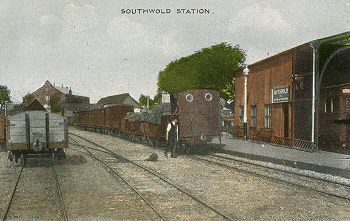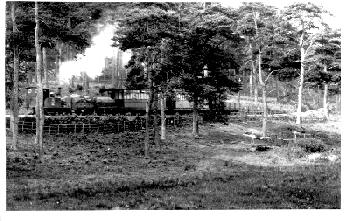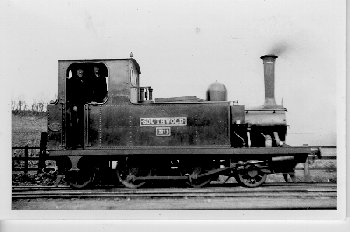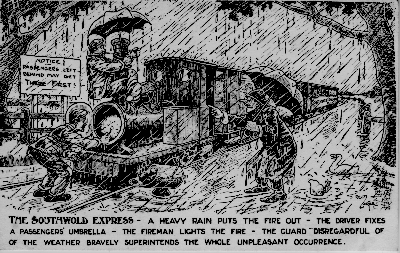The ancient port of Southwold adjoins marsh and heathland on the Suffolk coastline, twelve miles south of Lowestoft (the most easterly point in England). The once-important harbour declined during the 18th and 19th centuries in favour of Lowestoft – accentuating the need for tourists and trade – although there was still some fishing. In the 1850s, the East Suffolk Railway had taken a westerly course from Lowestoft to Ipswich, thus passing through Halesworth and Darsham, leaving Southwold 9 miles from a railway line. A once-daily horse-drawn omnibus service from Darsham was woefully inadequate. The East Suffolk Railway (and later the GER) refused requests for a branch line, and by 1875 local opinion had reached a peak. The Southwold Railway Company was formed with the help of local people (many of whom bought shares), a gauge of 3ft was chosen, and the Halesworth-based board set about raising the money. They had difficulties and were replaced by another board, with meetings transferred to the London offices of the new chairman, Richard Rapier. Having set up the scheme, the local people were less than amused at this and there was an element of ill feeling when the line opened on 24th September 1879 – despite the object of the exercise having being achieved.
The 8¾-mile line commenced at Southwold Station (near Buss Creek on the edge of Southwold) and proceeded through a cutting across Southwold Common and marshes, and thence across the River Blyth on a 146ft swing bridge – the only sizeable engineering structure on the line. Next came Walberswick Station, some half a mile from the village (a constant source of complaints). The site of the station now has a commemorative SRT seat.
From there, the line continued across the heath and through the Heronry to arrive at Blythburgh station. The section between Southwold and Blythburgh is for the most part eminently walkable, with the track formation clearly visible. Blythburgh station site is near to the White Hart pub and the magnificent 15th century church overlooking the Blyth estuary. The line then followed the course of the river Blyth over fields to Wenhaston Station, where the only set of public level crossing gates on the line were to be found. The last two miles to Halesworth passed Wenhaston Mill (and siding), a quarry, an engine shed, and then ran parallel to the East Suffolk main line before ultimately crossing Holton Road via a girder bridge to reach the exchange sidings and Halesworth station, which was connected to the adjacent GER/LNER main line station by a footbridge.
The Southwold Railway was single track throughout, worked on the one-engine-in-steam principle, although later the line was divided into 2 (later, 3) sections. Trains were almost invariably mixed, with shunting at intermediate stations. With a 16mph speed limit, this shunting must have added to the tedium of a 9-mile journey that took around 35 minutes; it was possible to cycle the journey quicker! The line was built on gently sloping countryside, so there were few notable earthworks and, apart from occasional flooding in the marshes, the operation was generally uneventful.
At the opening, the Southwold Railway had three engines manufactured by Sharp, Stewart & Co. Ltd. of Manchester – 2-4-0Ts imaginatively called ‘Southwold’, ‘Halesworth’ and ‘Blyth’. Traffic did not provide sufficient revenue at the outset to warrant three locos and No. 1 Southwold was returned to the makers in 1883; to be replaced later (in 1893) with a 2-4-2T (also called ‘Southwold’) as the increased volume of traffic rose steadily. In 1914 a much larger Manning Wardle 0-6-2T was obtained in anticipation of increased traffic from the Harbour Branch. Rolling stock included six 6-wheel coaches (originally with attractive balcony ends until rebuilt after the First World War); some 6-wheel coal trucks (some of which were owned by coal merchant Thomas Moy – thus being the only privately-owned wagons on an English narrow gauge railway); 2 goods vans and a selection of 4-wheel trucks, many with distinctive curved ends.
The Southwold Railway gradually developed, and in 1900 carried 10,000 passengers, 90,000 tons of minerals and 600 tons of general merchandise. Expansion was considered, including the mile-long harbour branch, a branch to Lowestoft (or Kessingland to meet a proposed GER branch there), a link to meet the mid-Suffolk Light railway in Halesworth or Laxfield, or conversion of the whole line to standard gauge. Priority was given to this last proposal although progress was slow, and eventually lack of finance led to its abandonment. The railway was thus left virtually the way it was when it opened. The harbour branch was eventually built, but the fishing trade was already in decline and the only advantage of the branch was a grant, which allowed the purchase of the fourth engine. The outbreak of WWI effectively killed of the fishing trade.
The line became a bit of a joke locally as this film shows. Although it provided an important link with the outside world, the eccentric coaches, engines and gauge – and the noted unreliability of the Southwold Railway – led to a series of now well-known postcards by local cartoonist Reg Carter, poking fun at the line (one of which is reproduced below).
After the First World War, financial depression caused a general decline in the fortunes of the line. Up to 1925 the line showed a profit, but when the end came, it was sudden. Motorbuses started outside Southwold in 1926 and the railway responded with increased services and reduced prices; but when the buses were permitted to pick up from within Southwold in 1928, even drastic cuts could not save the line. Essentially, the directors gave up and decided to cut their losses by closing the line rather than investing in an already out-dated railway.
On April 11th 1929, after one week’s notice, the line closed. This Gaumont News film footage exists of the last trains. So abrupt was the closure that the line had to carry on for a further ten days to clear the goods backlog. If a Southwold transport crisis was hoped for by the management (who had received little support from Southwold Corporation), it was not to be. Two separate plans to reopen the line quickly divided the support, and that was that. An abandonment order was applied for and, extraordinarily, was only eventually granted in the 1990s!
Because of this, the company existed for many years and no one was able to do anything about the line. When closed, stock was just left to rot at Halesworth. Scrap metal recovery for the Second World War provoked a last-ditch attempt to save the line (which failed of course), and in July 1941 the line and engines were cut up for scrap, realising the grand total of £1,500.
Reminders of the Southwold Railway still to be seen today:
- Southwold Station site is now a Police Station
- Southwold Cutting is now a delightful footpath, with evidence of the two base supports for the golf club footbridge, which provided access across the cutting until the 1960s
- The swing bridge has been replaced by a footbridge using the same plinths
- The last remaining section of track in situ is still to be found at the river’s edge opposite the Southwold Sailing Club at Blackshore Quay
- Walberswick Station building base has been uncovered and provided with a commemorative seat
- The coal shed at Blythburgh Station is still standing, the whole site currently receiving a sympathetic restoration by the Halesworth to Southwold Narrow Gauge Railway Society
- Wenhaston station site has been uncovered and a commemorative sign was erected in the year 2000 (although no longer in situ)
- The site of the exchange sidings and station at Halesworth is now a housing estate
- One of the two goods vans survived and is at the East Anglian Transport Museum at Carlton Colville, near Lowestoft
- There are small sections of track and sleepers visible in various places along the line, which is easily walkable from Blythburgh to Southwold.




